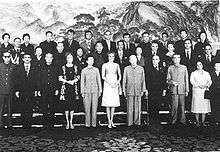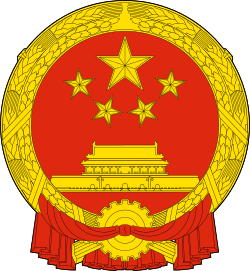China–Iran relations
 |
|
Iran |
China |
|---|---|
China–Iran relations typically refers to the economic, political, and social relations between the modern nations of the People's Republic of China and Iran, from the 1950s to the present day. Both the pre-1979 revolution Pahlavi dynasty of Iran and the post-revolutionary Islamic Republic of Iran have had diplomatic ties with China.
Although the relations between these two governments are relatively new, trade and diplomatic relations between the peoples and cultures within these two countries have existed since at least 200 BC. Throughout history, China and Iran have developed a friendly economic and strategic partnership.
Economic
Oil and gas
One of the main pillars of the relationship is oil and gas. China switched to petroleum primarily to get their energy supply off of coal. There was a rapid increase in oil importation from 1974 into the 1990s.[1] In 2011, approximately 10% of China's oil imports were from Iran.[2] Approximately 80% of China's total imports from Iran are oil and the rest is mineral and chemical products. Because of this reliance on Iranian oil and gas, China is now investing in the modernization of Iran's oil and gas sector to secure access to the resource.[3] The China National Petroleum Corporation (CNPC) was granted an $85 million contract to drill 19 wells in the natural gas fields in Southern Iran and signed another similar $13 million contract.[1] Then again in 2004, an agreement was reached where China would import 270 million tons of natural gas over 30 years from South Par fields which is the richest natural gas fields in the world for $70 billion. Another Chinese company, Sinopec Group, gets half-share in Yardarvaran oil fields worth about 100 billion for the purpose of exploration.[4] Later in 2007, CNPC signed a $3.6 billion deal to develop offshore gas fields in Iran and then signed another $2 billion contract to develop the northern Iranian oil field near Ahvaz. <[3] Not only is China helping to develop the oil and gas sector, but China supports Iran's ambitions to bring Caspian Sea oil and gas to Southern Iranian ports through pipelines so the resources can be exported to Europe and Asia.[1] Iran relies upon its oil sales to China to ensure its fiscal well-being.[3] China also sells gasoline to Iran despite international pressures that have halted Iran's ability to get gasoline from other suppliers.[5]
China finds in Iran a permanent partner for its exports and a source for its growing energy demand. In March 2004, Zhuhai Zhenrong Corporation, a Chinese state-run company, signed a 25-year contract to import 110 million metric tons of Liquefied Natural Gas (LNG) from Iran. This was followed by another contract between Sinopec and Iran LNG, signed in October of the same year. The deal, worth $100 billion, adds an extra 250 million tons of LNG to China's energy supply, to be extracted from Iran's Yadavaran field over a 25-year period. In January 2009, Iran and China signed a $1.76bn contract for the initial development of the North Azadegan oil field in western Iran. In March the two countries struck a three-year $3.39 billion deal to produce liquefied natural gas in Iran's mammoth South Pars natural gas field. Because of its limited refining capacity Iran imports one third of its refined products such as petrol from China.[6][7]

In 2011, the group Green Experts of Iran reported that Beijing and Tehran had signed an extensive deal that would give China exclusive rights to several Iranian oil and natural gas fields through 2024. Under the terms of the deal, Iran will give Chinese oil companies exclusive rights to three large regions of Iranian land as well as the rights to build all necessary infrastructure for these regions, all of which sit atop of large oil and natural gas fields. In return, China promises to treat any foreign attack against these regions as attacks against its own sovereign territory, and will defend them as such. China will have no need for prior permission from the Iranian government to maintain and increase its military presence in Iran, and will control the movement of Iranians in and out of these territories.[8] The Green Experts of Iran speculate that this agreement was the concrete basis for Major General Zhang Zhaozhong's statement that "China will not hesitate to protect Iran even with a third World War." [9]
Trade
There existed unofficial trade relations between Iran and China during the cold war and steadily increased. Trade reached 1.627 billion in the 1980s and 15 billion in 2007. In 2001, the volume of trade between Iran and China stood at roughly $3.3 billion,[10] and in 2005, the volume of Sino-Iranian trade hit US$ 9.2 billion.[11] Iran's Deputy Minister of Commerce Mehdi Ghazanfari speculated that trade exchanges between Iran and China would exceed $25 billion in 2008.[12] In 2005, exports from China represented 8.3% of the total import market in Iran, giving China the second largest share of the market after Germany. China's exports to Iran have experienced particularly rapid growth in the past five years, with China replacing Japan as the world's second largest exporter to Iran. Iran's imports from China rose by 360% between 2000 and 2005.[13] China is now responsible for about 9.5% of all Iranian imports. In 1988, the Iranian market opened up to Chinese industry when the PRC began economic restructuring.[1] Once profitable trade relations were established, the PRC invested in Tehran's subway systems, dams, fishery, and cement factories while Iran helped supply China with the highly desired minerals coal, zinc, lead, and copper.<[1][4] Trade between the two states also included power generation, mining, and transportation equipment along with arms and consumer goods such as electronics, auto parts, and toys.[5] Iran–China trade value reached $45 billion in 2011 and was expected to increase to $50 billion by 2012.[14]
Ali Akbar Salehi, Iran's former representative to the International Atomic Energy Agency, said that the two countries "mutually complement each other. They have industry and we have energy resources".[15]
While cargoes are usually shipped between China and Iran by ship, it is also possible to travel between the two countries by train, via Kazakhstan and Turkmenistan (see Eurasian Land Bridge). In 2016, a first direct container train between Yiwu (Zhejiang Province) and Teheran made its way across Asia in 14 days. This is supposed to be the beginning of regular container train service along this route.[16]
Political
.jpg)
Military
China is believed to have helped Iran militarily in the following areas: conduct training of high-level officials on advanced systems, provide technical support, supply specialty steel for missile construction, provide control technology for missile development, build a missile factory and test range. It is rumored that China is responsible for aiding in the development of advanced conventional weapons including surface-to-air missiles, combat aircraft, radar systems, and fast-attack missile vessels.[3] It was not until the 1990s that the relationship between China and Iran came under close scrutiny by the United States. From this scrutiny it became known that China was using North Korea to traffic arms during the Iran-Iraq war to avoid antagonizing the West but later cut out the middle man. In the years of 1984–1986, about $1–2 billion worth of arms sales occurred.[17] And then in 1986, Iran obtained Chinese-made anti-ship surface-to-surface missiles that posed a threat to Persian Gulf shipping.[3] In possessing these missiles, Iran is able to control the Straits of Hormuz and all of the naval trade to and from the Gulf countries.[17] In later inquiries, it was discovered that China sold Iran precursor and dual-use chemicals and the technology and equipment needed to use them.[3] In 1996, the Washington Post exposed that China was supplying chemical weapons plants in Iran that were destined for the Army. Arms exports began to steadily decline in the 1990s yet China engaged in $400 million worth of arms transfer agreements with Iran. Sales increased to $600 million from 1997-2000. On average, it is estimated that China made $171 million per year in arms exports to Iran since 1982.[18]
Nuclear weapons
Nuclear cooperation began in the 1980s when China helped build a research reactor and supply four other research reactors. Continued aid came in the form of helping Iran construct a uranium hexafluoride enrichment plant near Isfahan and resume construction on a nuclear power plant at Bushehr that was left uncompleted by the French and Germans. In 1991, nuclear exports to Iran were discovered by the International Atomic Energy Association, which contained three types of uranium. A 1990 covert nuclear agreement was also discovered.[18] This discovery was followed by an unprecedented nuclear cooperation agreement in 1992. The agreement was signed despite US protests to have China limit its nuclear cooperation with Iran.[19] Direct nuclear cooperation has ended but there is speculation over whether there remains indirect nuclear cooperation.[18] For example, in 2005, 7 Chinese firms were suspected of selling nuclear weapons technology and all 7 had sanctions placed upon them. Those firms were banned from trading with the United States for two years.[20] There also continues to be Chinese nuclear experts, scientists, and technicians present in Iran.[18] Now, China opposes Iran's possible production and possession of nuclear weapons but does not see the urgency to stop it.[3]
Politics and ideology
Chinese Muslims fought against Japan in World War II. In order to gain backing for China in Muslim countries, Egypt, Syria, and Turkey was visited by Hui Muslim 馬賦良[21] Ma Fuliang and Uyghur Muslim Isa Yusuf Alptekin in 1939.[22] The Hindu leaders Tagore and Gandhi and Muslim Jinnah both discussed the war with the Chinese Muslim delegation under Ma Fuliang while in Turkey İsmet İnönü met with the Chinese Muslim delegation.[23] Newspapers in China reported the visit.[24] Ma Fuliang and Isa were working for Zhu Jiahua.[25]
The bombardment of Chinese Muslims by the warplanes of the Japanese was reported in the newspapers of Syria. Afghanistan, Iran, Iraq, Syria, and Lebanon were all toured by the delegation. The Foreign Minister, Prime Minister, and President of Turkey met with the Chinese Muslim delegation after they came via Egypt in May 1939. Gandhi and Jinnah met with the Hui Ma Fuliang and Uyghur Isa Alptekin as they denounced Japan.[26]
Official diplomatic relations were established in 1971. Before 1971, an unofficial relationship existed out of necessity. From this emerged the current relationship. The first Iranian embassy was formed in December 1973 and Abbas Aram was appointed to the post, becoming the first Iranian diplomat to serve in China.[27] In the 1980s, the shared ideological themes of anti-imperialism and third world solidarity helped solidify the relationship but they became allies as a way to counterbalance the Soviet Union and the United States during the Cold War. When the USSR signed the Soviet-Indian friendship treaty, the relationship became a way to counter increasing Russian influence in the Persian Gulf. But there remained some distance between Mao's regime and that of the Shah because of ideology. The Shah was friendly towards the United States and Mao was communist. The Shah also feared that the relationship could rally his communist opposition. Once the Shah was overthrown during the Islamic Revolution, China quickly recognized the new government on 14 February 1979.[27] China was put into a difficult situation during the Iran–Iraq War in 1980 since China was allies with both nations. China was able to remain outside of the conflict and push for a peaceful resolution to the conflict.[1]
The political and economic ties between China and Iran are not ironclad. China has been at times careful in its deals with Iran while simultaneously trying not to antagonize China's relationship with the US as well as its growing relations with Israel. The cooperation emerges partly from Chinese and Iranian recognition as a fellow heir to a great civilization and because Iran has emerged as the regional leader in the Middle East. While there is also a shared distrust of the United States' government and its interests, many young Chinese and Iranians at the same time admire certain aspects of American society and culture. There is also Iranian admiration for China's rapid economic growth, and for the most part, their economic contributions to Iran are appreciated and respected.[5]
Some analysts argue that Iran can use its links with China to build more links across Asia while remaining insulated from potential U.S. attack.[4]
In April 2015, China stated that Iran had been officially accepted as a founding member of its newly founded Asian Infrastructure Investment Bank, with the latter owning 15,808 shares.[28][29][30] There has also been discussion as of late for Iran to eventually join the Shanghai Cooperation Organisation, of which it is currently an observer state, as a full member.
China, Iran and the UN
Iran did not originally support China's bid for United Nations membership but did not veto it. It wasn't until 1969 that Iran displayed open support for China's membership.[1] Now, it is seen that Iran relies upon China's membership and especially Chinese veto power on the Security Council to protect it from UN or US led action.[4] China is known for its opposition of sanctions against another state and favors diplomatic efforts. This tradition includes China's position on UN sanctions against Iran in the past.[3] In 1980, China refused to support the UN arms embargo against Iran and abstained from voting on US-based sanctions against Iran as well.[1] It was not until 2010 that China entertained the idea of joining in on the economic sanctions presented against Iran.[3] China supported the 2010 UN sanctions which caused some tension and reevaluation of Iranian-Chinese relations. In retaliation, Iran briefly aroused interest in the plight of Muslims in China.[5]
Social
There are several social connections between the two states. The two societies psychologically identify with one another because they both share the national pride and historical identity that comes along with being descendant of two great empires and modern successor-states to ancient civilizations. Despite the psychological difference, there existed limited interactions after the Chinese Revolution in 1949 but social interactions improved after the 1960s. Now there exists open support for the other regime as seen in Iran's support of the action at Tienanmen Square and Chinese condemnation of the United States' attack on an Iranian passenger plane.[1] Even Chinese state-ran news agencies upheld the validity of the internationally controversial election and ultimately attributed any problems that day to terrorists and vandals. They purposefully left out images of Iranian security forces brutalizing the protesters.[3] Iranian media has occasionally complained about Chinese price gouging, material inferiority, and that the cheap Chinese imports are driving small Iranian businesses out of business.[5] Despite some of the critical press China has attracted in Iran, about 2,000 Chinese now live in Tehran and 70 Chinese companies relocated to Iran. Recently, Tehran has experienced the introduction of Chinese restaurants into cultural life.[4]
See also
- An Shihkao
- Foreign relations of Imperial China
- Foreign relations of Iran
- Foreign relations of the People's Republic of China
- Peroz III
- Shanghai Cooperation Organization
- Sino-Persian relations
Bibliography
- Cardenal, Juan Pablo; Araújo, Heriberto (2011). La silenciosa conquista china (in Spanish). Barcelona: Crítica. pp. 70–79; 140–144.
References
- 1 2 3 4 5 6 7 8 9 Dorraj, Manochehr and Currier, Carrie L (2008). "Lubricated with Oil: Iran-China Relations in a Changing World" Middle East Policy
- ↑ China, U.S. Energy Information Administration
- 1 2 3 4 5 6 7 8 9 10 George L. Simpson Jr. (2010). "Russian and Chinese Support for Tehran" Middle East Quarterly
- 1 2 3 4 5 Vivienne Walt (2005). "Iran Looks East" Fortune
- 1 2 3 4 5 Erica Downs & Suzanne Moloney (2011). "Getting China to Sanction Iran" Foreign Affairs
- ↑ "Economy", Iran Daily, archived from the original on 22 April 2009
- ↑ "Business", Al Jazeera, 23 September 2009
- ↑ "In a Treasonous Act, Iranian Regime Sells Out Parts of the Country to China!". CNN.Translated from اختصاصی/ الحاق برخی مناطق کشور به حوزه منافع ملی چین / خیانت رسمی حکومت به استقلال ایران Retrieved 23 January 2012
- ↑ "China must protect Iran even with WWIII". Press TV. Retrieved 22 January 2012.
- ↑ News, Iran Vajahan
- ↑ "News", Payvand, July 2006
- ↑ "Economy", Iran Daily
- ↑ "News", Payvand, May 2006
- ↑ "Iran and China to expand trade relations", Payvand, 4 January 2012
- ↑ Robin Wright (17 November 2004). "Iran's New Alliance With China Could Cost U.S. Leverage". The Washington Post.
- ↑ "CNCNEWS - Yiwu-Tehran cargo train".
- 1 2 Dennis Van Vranken Hickley (1990). "New Directions in China's Arms for Export Policy: Of China's Military Ties with Iran" Asian Affairs
- 1 2 3 4 Therese Delpech (2006). Iran and the Bomb: The Abdication of International Responsibility. Columbia University Press ISBN 978-0-231-70006-1
- ↑ Alidad Mafinezam and Aria Mehrabi (2008). Iran and Its Place Among Nations. Praeger Publishers ISBN 978-0-275-99926-1
- ↑ Sharif Shuja (2005). "China, Iran and Central Asia: The Dawning of a New Partnership" Contemporary Review
- ↑ Hsiao-ting Lin (13 September 2010). Modern China's Ethnic Frontiers: A Journey to the West. Routledge. pp. 126–. ISBN 978-1-136-92393-7. http://wenku.baidu.com/view/b09c1314a8114431b90dd89a.html?re=view
- ↑ Hsiao-ting Lin (4 August 2010). Modern China's Ethnic Frontiers: A Journey to the West. Taylor & Francis. pp. 90–. ISBN 978-0-203-84497-7.Hsiao-ting Lin (13 September 2010). Modern China's Ethnic Frontiers: A Journey to the West. Routledge. pp. 90–. ISBN 978-1-136-92392-0.Hsiao-ting Lin (13 September 2010). Modern China's Ethnic Frontiers: A Journey to the West. Routledge. pp. 90–. ISBN 978-1-136-92393-7.
- ↑ http://www.huizu360.com/huizu/news_view.asp?tid=5&id=19276
- ↑ http://contentdm.lib.nccu.edu.tw/cdm/ref/collection/38clip/id/34722
- ↑ http://www.qh.xinhuanet.com/2009-11/27/content_18352582.htm
- ↑ http://www.xzbu.com/7/view-1606508.htm
- 1 2 John W. Garver (1 July 2006). China and Iran: Ancient Partners in a Post-Imperial World. University of Washington Press. p. 308. ISBN 978-0-295-80121-6. Retrieved 29 November 2013.
- ↑ Reuters Editorial (8 April 2015). "China says Iran joins AIIB as founder member". Reuters.
- ↑ Angelo Young (7 April 2015). "China Welcomes Iran, UAE To Asian Infrastructure Investment Bank; Founding Members Now Number 35". International Business Times.
- ↑ "Farsnews".

